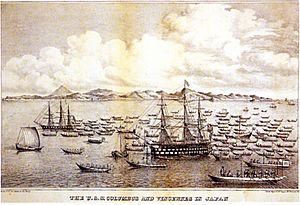Kōka facts for kids
The Kōka (弘化) was a special time period, or nengō, in Japan. It came after the Tenpō era and before the Kaei era. This period lasted from December 1844 to February 1848. During the Kōka era, two emperors ruled Japan: Emperor Ninkō and his son, Emperor Kōmei.
Key Events of the Kōka Era
- 1844 (Kōka 1): A person named Takashima Tomonosuke was born.
- 1846 (Kōka 3): Two ships from the United States Navy tried to enter Uraga, a port near what is now Tokyo Bay. However, they were turned away and had to leave.
- February 21, 1846 (Kōka 3): Emperor Ninkō passed away. His son, Emperor Kōmei, then became the new ruler of Japan. This change of power is called senso. Soon after, special ceremonies, known as sokui, officially confirmed Emperor Kōmei's role as the emperor.
- March 1846 (Kōka 3): A strong earthquake hit the Sanriku region of Japan. It had a magnitude of 6.9 on the Richter scale.
- May 9, 1847 (Kōka 4): Another earthquake occurred in Nagano. This one was even stronger, with a magnitude of 7.4 on the Richter scale.
- 1848 (Kōka 5): The last traditional Noh performance that people paid to see took place. Noh is a very old form of Japanese musical drama.
During the Kōka era, a famous artist named Hiroshige started creating prints. These prints often showed women in beautiful and well-known places.
More to Explore
- You can learn more about the Japanese calendar and see old pictures at the National Diet Library's website: The Japanese Calendar
See also
 In Spanish: Kōka para niños
In Spanish: Kōka para niños

All content from Kiddle encyclopedia articles (including the article images and facts) can be freely used under Attribution-ShareAlike license, unless stated otherwise. Cite this article:
Kōka Facts for Kids. Kiddle Encyclopedia.

